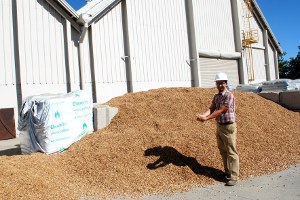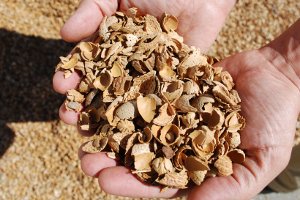"So we've got more almond shells than anybody else. And you know, we know some companies that handle almond shells and they're always looking for somewhere to take them," says Summers.
[jwplayer config="QUEST Audio Player" skin="http://ww2.kqed.org/quest/wp-content/themes/quest/glow.zip" file="http://www.kqed.org/.stream/anon/radio/quest/2011/03/2011-03-28-quest.mp3" ]
Listen to the QUEST radio story How Green Is Biomass Energy?
But where some see a waste product, Summers sees an energy source.
"So this is the heart of the West Biofuels process," he says, pointing to a tower of industrial equipment that turns almond shells into electricity. First, the waste, or biomass, is fed into a reactor.
"We call it reforming, so we're re-forming what's biomass, what's almond shells into smaller particles that are gases," says Summers, describing their gasification technology.
The gas that's produced is a lot like natural gas, so it goes to an advanced generator where it's burned to produce electricity.
But this is where biomass is different from other renewables. The generator produces air pollution, unlike, say, a solar farm. So Summers and his team use pollution control technology to meet California's air quality standards.
Still, despite the emissions from biomass plants, many say there are big benefits to using waste as an energy source.
"Waste is pretty green," says Jim Boyd, a member of the California Energy Commission. "There's enough material out there to make thousands of megawatts of electricity."
 Matt Summers of West Biofuels stands next to their fuel source.
Matt Summers of West Biofuels stands next to their fuel source.
There are a lot of unused energy sources out there, Boyd says, like construction debris and orchard cuttings. Biomass energy also has one big advantage over other renewables - reliability. Wind and solar power are variable since the sun and wind aren't available all the time.
"And instead of just thinking about building more natural gas plants to fill the void, we could utilize biomass plants because they are seven by 24 once you get them up and running," says Boyd.
But while other renewables are booming, biomass is on the decline in California. After dozens of plants were built in the 1980s, today, only a handful of new plants are being proposed. In 2009, biomass provided about two percent of the state's electricity.
"There's a great infatuation with wind and solar and very rare references to biomass and some of us are trying to turn that around a little bit," Boyd says.
One problem is simply cost. Biomass facilities need tons and tons of material and trucking it in from around the state isn't very economical.
The other issue gets back to the concern of whether biomass energy is really as green as supporters say. There's the problem of greenhouse gas emissions from biomass plants. Another controversy is over one particular fuel source: trees.
All those years of Smokey Bear and fire suppression in California have created very dense forests – which are at high risk for fires. Both private and public land managers have been trying to reduce that fuel load.
"In a lot of cases you'd do thinning operation where you take out some of the trees, usually the smaller trees, the less valuable trees," says Bill Stewart, a forestry specialist at the University of California - Berkeley.
Stewart says most of the material removed from forests is either burned or left to decay. So there's a lot of interest in using forestry waste in biomass plants.
But Debbie Hammel of the Natural Resources Defense Council says, "I think if you're talking about waste, it's important to define what you mean."
"If you take too much of that residue out of the forest, you're going to have an impact on the forest floor, the fertility of the soil, erosion and potentially wildlife habitat."
Hammel says there's a major debate over how much thinning is good for a forest. So, she worries that a larger biomass industry would create incentives to over-harvest forests. That's why Hammel says not all biomass is equal - and why waste like almond shells should be used before forest cuttings.
"There is a role for biomass done right, but it's a smaller role I think than some people imagine," says Hammel.
Looking ahead, Hammel says the next thorny issue is calculating the greenhouse gas emissions from biomass plants, which can be tricky since the fuels come from a number of sources. That's something the federal Environmental Protection Agency is reviewing now.
38.714854 -121.75320
 Almond shells at the West Biofuels biomass test plant in Woodland, California.
Almond shells at the West Biofuels biomass test plant in Woodland, California.
